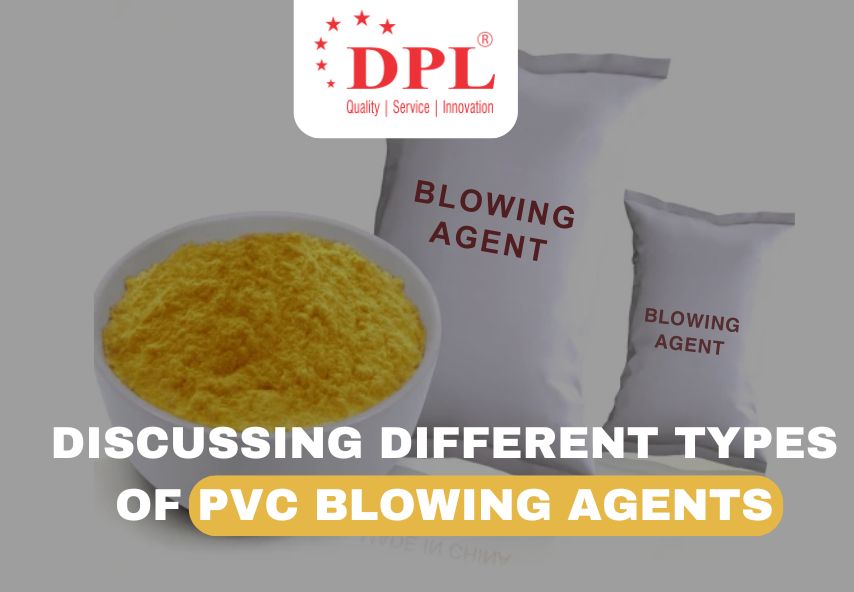
The production of polyvinyl chloride (PVC) foam involves a crucial component which is blowing agents. These specialized substances play a significant role in creating the desired foam structure, imparting lightweight and insulating properties to the final product. The chemical industry is ever-evolving, and manufacturers rely on various types of PVC blowing agents to meet diverse application requirements. DPL Group of companies are the Best industrial chemicals manufacturer in India. Now we are going to discuss the different types of PVC blowing agents.
When we are Discussing types of PVC blowing agents, two main categories emerge, the first one is chemical blowing agents and the second one is physical blowing agents. Let’s explore each one in detail.
Types of PVC Blowing Agents
1. Chemical Blowing Agents –
Chemical blowing agents, also known as foaming agents. It is a chemical reaction that generates gas. The generation of gas leads to the formation of foam cells within the PVC matrix. These agents are typically added to the PVC compound during the extrusion or moulding process. As the temperature rises, the chemical blowing agent decomposes and releases gases that cause the PVC to expand and form a cellular structure.
Azodicarbonamide (ADCL):-
Azodicarbonamide is a widely utilized chemical blowing agent renowned for its efficiency and versatility. Upon heating, ADCL releases nitrogen gas and facilitates the controlled expansion of the PVC compound. This agent finds extensive applications in various industries, including construction, automotive, and packaging.
Sodium Bicarbonate:-
Sodium bicarbonate, a common household ingredient, serves as an effective chemical blowing agent when combined with an acid source. The reaction between sodium bicarbonate and the acid source generates carbon dioxide gas. It creates a foaming effect within the PVC material. This agent is often preferred for its cost-effectiveness and availability.
Organic Acid Salts:-
Organic acid salts, such as citric acid salts or oxalic acid salts, are another category of chemical blowing agents used in PVC foam production. These agents release carbon dioxide gas when heated, contributing to the formation of a uniform cell structure within the PVC foam.
2. Physical Blowing Agents –
In contrast to chemical blowing agents, physical blowing agents rely on the direct incorporation of gases into the PVC compound during the extrusion or moulding process. These agents remain inert throughout the manufacturing process and ensure a consistent and controlled foaming action.
Hydrocarbons:-
Hydrocarbons, such as butane, isobutane, and pentane, are commonly employed as physical blowing agents in PVC foam production. These gases are injected into the molten PVC compound, where they create a foaming effect as the pressure is released during the extrusion or moulding process.
Carbon Dioxide:-
Carbon dioxide (CO2) is a popular physical blowing agent due to its non-flammable and environmentally friendly nature. It is introduced into the PVC compound under high pressure, allowing for the formation of a uniform foam structure upon depressurization.
Nitrogen:-
Nitrogen gas is another physical blowing agent widely used in the PVC foam industry. Its inert properties make it a safe and reliable choice for creating lightweight and insulating PVC foam products.
How to choose the right Blowing Agent –
The selection of the appropriate blowing agent depends on various factors, including the desired foam density, cell structure, and end-use application. Chemical blowing agents offer the advantage of cost-effectiveness and ease of handling, while physical blowing agents provide greater control over the foaming process and often result in a more consistent cell structure.
Moreover, environmental considerations and regulatory requirements play a crucial role in the choice of blowing agents. If you are for the Best Blowing Agent Supplier in India, contact DPL Group of companies right away.
Conclusion –
The types of PVC blowing agents available to manufacturers offer a diverse range of options, each with its unique advantages and applications. Whether it’s chemical blowing agents that undergo chemical reactions or physical blowing agents that rely on gas injection, these substances are the driving force behind the creation of lightweight, insulating, and versatile PVC foam products. By carefully selecting the appropriate blowing agent and optimizing the manufacturing process, companies can produce high-quality PVC foams tailored to meet the specific needs of various industries.
